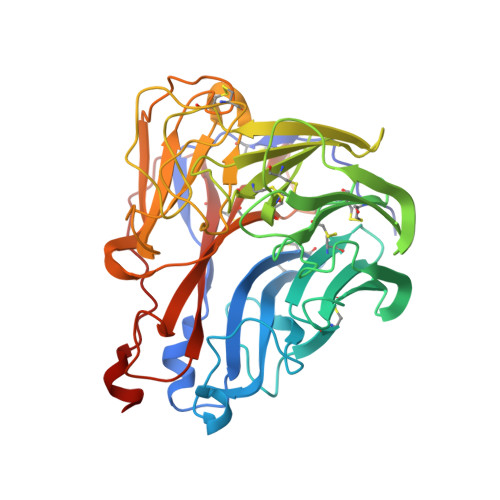Drug Susceptibility Evaluation of an Influenza A(H7N9) Virus by Analyzing Recombinant Neuraminidase Proteins.
Gubareva, L.V., Sleeman, K., Guo, Z., Yang, H., Hodges, E., Davis, C.T., Baranovich, T., Stevens, J.(2017) J Infect Dis 216: S566-S574
- PubMed: 28934455
- DOI: https://doi.org/10.1093/infdis/jiw625
- Primary Citation of Related Structures:
5L14, 5L15, 5L17, 5L18 - PubMed Abstract:
Neuraminidase (NA) inhibitors are the recommended antiviral medications for influenza treatment. However, their therapeutic efficacy can be compromised by NA changes that emerge naturally and/or following antiviral treatment. Knowledge of which molecular changes confer drug resistance of influenza A(H7N9) viruses (group 2NA) remains sparse. Fourteen amino acid substitutions were introduced into the NA of A/Shanghai/2/2013(H7N9). Recombinant N9 (recN9) proteins were expressed in a baculovirus system in insect cells and tested using the Centers for Disease Control and Prevention standardized NA inhibition (NI) assay with oseltamivir, zanamivir, peramivir, and laninamivir. The wild-type N9 crystal structure was determined in complex with oseltamivir, zanamivir, or sialic acid, and structural analysis was performed. All substitutions conferred either reduced or highly reduced inhibition by at least 1 NA inhibitor; half of them caused reduced inhibition or highly reduced inhibition by all NA inhibitors. R292K conferred the highest increase in oseltamivir half-maximal inhibitory concentration (IC50), and E119D conferred the highest zanamivir IC50. Unlike N2 (another group 2NA), H274Y conferred highly reduced inhibition by oseltamivir. Additionally, R152K, a naturally occurring variation at the NA catalytic residue of A(H7N9) viruses, conferred reduced inhibition by laninamivir. The recNA method is a valuable tool for assessing the effect of NA changes on drug susceptibility of emerging influenza viruses.
Organizational Affiliation:
Influenza Division, National Center for Immunization and Respiratory Diseases, Centers for Disease Control and Prevention.

















